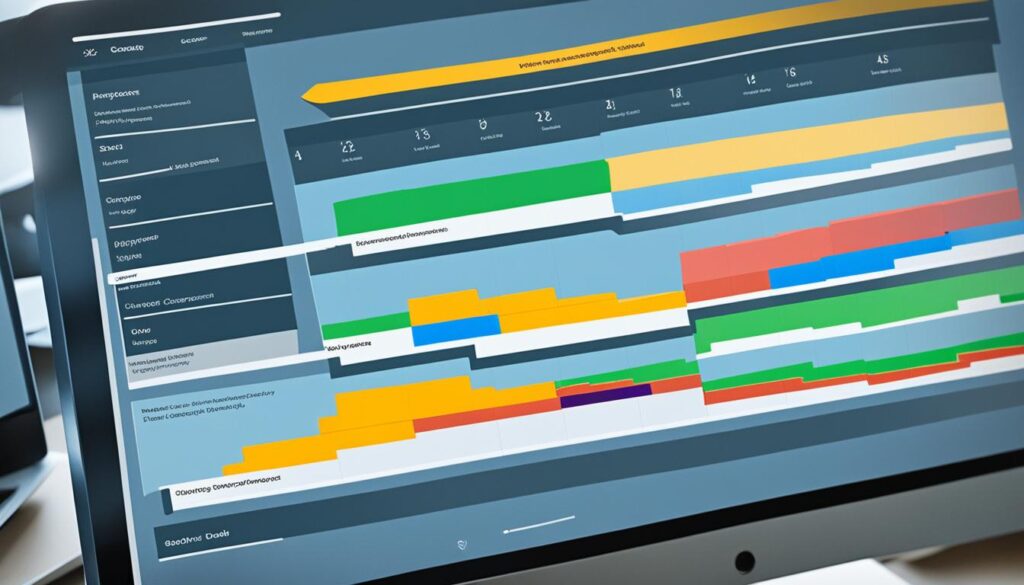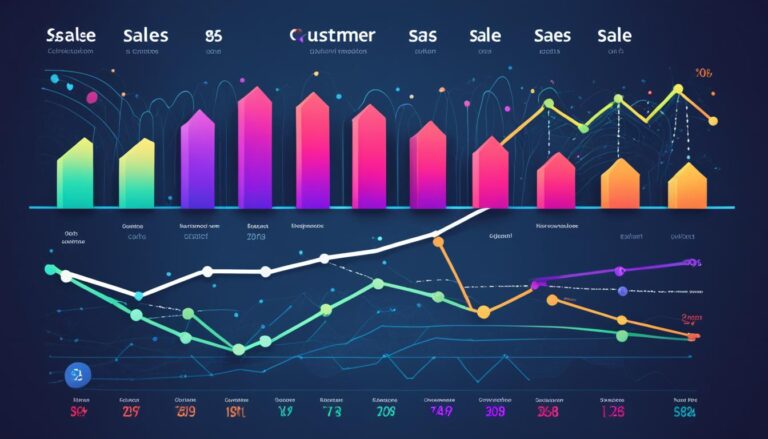Boost Your Team Productivity Today!

Do you ever find yourself wondering why some teams seem to consistently outperform others? What if there were simple yet effective strategies that could help you boost your team’s performance and improve overall productivity? It’s time to discover the key to enhancing group productivity and increasing collaboration effectiveness.
Key Takeaways:
- Implementing realistic and effective ways to increase team productivity
- Understanding the value of productivity at both the company and employee level
- Rewarding quality work over quantity
- Monitoring project progress and setting deadlines
- Harnessing the power of standing meetings for effective communication
What is Team Productivity?
Productivity refers to the output created by an individual or a team. For individuals, productivity is measured by the tasks they accomplish in a day, while at the team level, productivity relates to the completion of projects and assigned tasks. The productivity of a team is valuable to both the company and its employees, as it contributes to the overall mission and can lead to career progression.
Collaboration plays a crucial role in team productivity, as it allows individuals to leverage their strengths and work together towards a common goal. By combining individual capabilities and expertise, teams can achieve higher levels of output and excellence in their work.
When teams are productive, they are better equipped to meet deadlines, deliver high-quality work, and drive successful outcomes. This not only benefits the company as a whole but also enhances the value and worth of each employee within the team.
By harnessing the power of collaboration and maximizing individual and team productivity, organizations can create an environment that fosters innovation, growth, and success.
Rewarding Quality over Quantity
In the pursuit of enhancing team productivity, it is crucial to recognize and reward quality work. Instead of solely focusing on the quantity of work completed, placing a greater emphasis on the quality of efforts can lead to superior outcomes and customer satisfaction. By incentivizing behaviors that prioritize quality, you can foster a culture of excellence within your team.
Recognizing team members who consistently deliver high-quality work is a powerful way to encourage others to follow suit. Publicly praising their efforts not only boosts motivation but also sets a standard for excellence that others strive to achieve. By rewarding quality work at the team level, you reinforce the importance of customer satisfaction and drive the team to consistently deliver exceptional results.
Incentivizing behavior that prioritizes quality over quantity can yield remarkable benefits. When team members understand that their success is measured by the impact they make rather than the volume of work produced, they are more likely to approach their tasks with a focus on quality. This mindset shift enhances overall team performance and fosters a sense of pride in delivering work that exceeds expectations.
Moreover, rewarding quality work reinforces the significance of customer satisfaction. By recognizing and celebrating the contributions that directly improve the customer experience, you align your team’s efforts with the organization’s overarching goals. This alignment creates a shared commitment to customer satisfaction, driving the team to consistently deliver exceptional results that leave a lasting positive impact on your customers.
Benefits of Rewarding Quality over Quantity:
- Enhances team motivation and morale
- Promotes a culture of excellence
- Fosters a customer-centric approach
- Improves overall team performance
- Drives exceptional results and customer satisfaction
When it comes to elevating team productivity, remember that recognizing and rewarding quality work is a powerful tool. By incentivizing behaviors that prioritize excellence, you not only motivate your team members but also cultivate a high-performing team that consistently delivers exceptional results and exceeds customer expectations.

Monitoring Progress
Tracking the progress of your projects is essential for maintaining team productivity. By closely monitoring the status of tasks, you can ensure that everything stays on track and deadlines are met. There are several effective methods you can employ to keep a watchful eye on project progress:
1. Utilize Productivity Tools
Take advantage of the wide range of productivity tools available to help you track projects and keep your team organized. These tools provide a centralized platform for task management, deadline tracking, and collaboration. With features like progress updates, shared calendars, and notifications, you can easily monitor the status of each project and ensure accountability.
2. Set Clear Deadlines
Establishing clear and realistic deadlines is crucial for project management. By defining specific due dates for each task, you create a sense of urgency and encourage team members to prioritize their work. With clearly stated deadlines, it becomes easier to track progress and identify any delays or bottlenecks.
3. Break Down Tasks
Complex projects can be overwhelming if not properly managed. To facilitate progress tracking, break down large tasks into smaller, more manageable steps. This not only helps team members to focus on specific objectives but also allows for more accurate monitoring of individual and overall project progress.
4. Regularly Report on Status
Implement a system for regular status reporting, whether it’s through daily stand-ups, weekly meetings, or progress updates. This provides an opportunity for team members to share updates, discuss any challenges, and align their efforts. Regular reporting ensures transparency and allows for timely intervention if any issues arise.
5. Foster Accountability
Hold team members accountable for their assigned tasks and ensure they take ownership of their work. Encourage open communication about progress, obstacles, and proposed solutions. By establishing a culture of accountability, you create an environment where everyone takes responsibility for their actions, leading to increased productivity and timely project completion.
By implementing these monitoring strategies, you can stay informed about project progress, identify potential roadblocks, and take proactive measures to keep your team on track. Remember, consistent tracking and reporting contribute to improved productivity and successful project delivery.

Holding Standing Meetings
Standing meetings are a valuable practice to enhance team productivity. These short and focused meetings provide an ideal platform for effective communication, sharing of work, and exchanging alternative perspectives. In a standing meeting, team members collaborate, brainstorm ideas, and provide valuable feedback, fostering a culture of open and constructive communication.
One of the best practices for holding standing meetings is to have a clear agenda. By setting specific discussion topics and goals for each meeting, you ensure that the time is optimized and everyone stays focused on the key objectives. Additionally, keeping standing meetings short and concise is crucial to maintain engagement and prevent unnecessary delays. Shorter meetings encourage participants to articulate their thoughts more efficiently and eliminate unnecessary discussions, resulting in improved overall productivity.
Remote work is becoming increasingly common, and it’s essential to include remote team members in standing meetings. Making remote participation easy by utilizing video conferencing tools and providing clear meeting instructions ensures equal participation and collaboration. Embracing remote team members’ perspectives and ideas enriches the discussions and contributes to better decision-making.
Ultimately, standing meetings promote effective communication, diverse viewpoints, and timely feedback, which are essential for enhancing team productivity.
Benefits of Holding Standing Meetings:
- Encourages effective communication and collaboration
- Fosters the exchange of alternative perspectives and ideas
- Promotes timely feedback and constructive criticism
- Optimizes meeting time and reduces unnecessary discussions
- Strengthens team bonds and enhances team spirit

| Best Practices for Holding Standing Meetings: |
|---|
| 1. Set a clear agenda for each meeting. |
| 2. Keep the meetings short and focused. |
| 3. Encourage equal participation for remote team members. |
| 4. Embrace diverse perspectives and encourage open communication. |
| 5. Provide timely feedback and celebrate achievements. |
Creating a Healthy Work Environment
A healthy work environment is crucial for maximizing team productivity. By prioritizing elements such as work-life balance, stress management, and team connections, you can foster a positive atmosphere that promotes engagement, well-being, and effective collaboration.
Encourage Work-Life Balance
One of the key factors in maintaining a healthy work environment is supporting work-life balance. Encourage team members to set boundaries and establish a separation between work and personal life. By promoting a healthy integration of work and personal responsibilities, you can help prevent burnout and improve overall job satisfaction.
Provide Support for Stress Management
Stress is an inevitable part of work, but it’s important to implement strategies to manage and alleviate it. Offer resources and support systems that help team members effectively cope with stress. This could include access to stress management workshops, wellness programs, or mental health services. By addressing stress proactively, you can create an environment where employees feel supported and equipped to handle challenges.
Foster Team Connections
Strong team connections play a vital role in building a healthy work environment. Encourage collaboration, open communication, and team-building activities. Foster an inclusive atmosphere where colleagues can connect, share ideas, and collaborate effectively. Team connections not only improve productivity but also enhance employee engagement and job satisfaction.

A positive work environment has a significant impact on productivity and team performance. Investing in work-life balance, stress management, and team connections helps create a supportive culture that empowers individuals and fosters collaboration.
Setting a North Star
To boost team productivity and maximize collective efforts, it is crucial to set a clear, unifying goal. This goal, also known as a North Star metric, serves as a guiding light, providing direction and purpose to the team. By aligning team goals with the overall objectives of the company, you create a sense of unity and focus that can drive productivity to new heights.
Measuring progress is essential in achieving team goals. By implementing metrics that reflect the desired outcomes, you can track the team’s performance and make data-driven decisions. Consider using metrics such as customer satisfaction, project completion rates, or specific performance indicators that align with your objectives. Regularly reviewing and analyzing these metrics will not only give you a clear picture of the team’s progress but also enable you to identify areas for improvement.
When team members understand the larger purpose behind their work and see how their contributions impact the team’s success, they are more likely to be motivated and engaged. Celebrating achievements along the way, whether they are milestones or successful outcomes, can foster a sense of accomplishment and create a positive work environment. Recognizing and acknowledging individual and team achievements not only boosts morale but also encourages continuous improvement and dedication to reaching the unifying goal.





